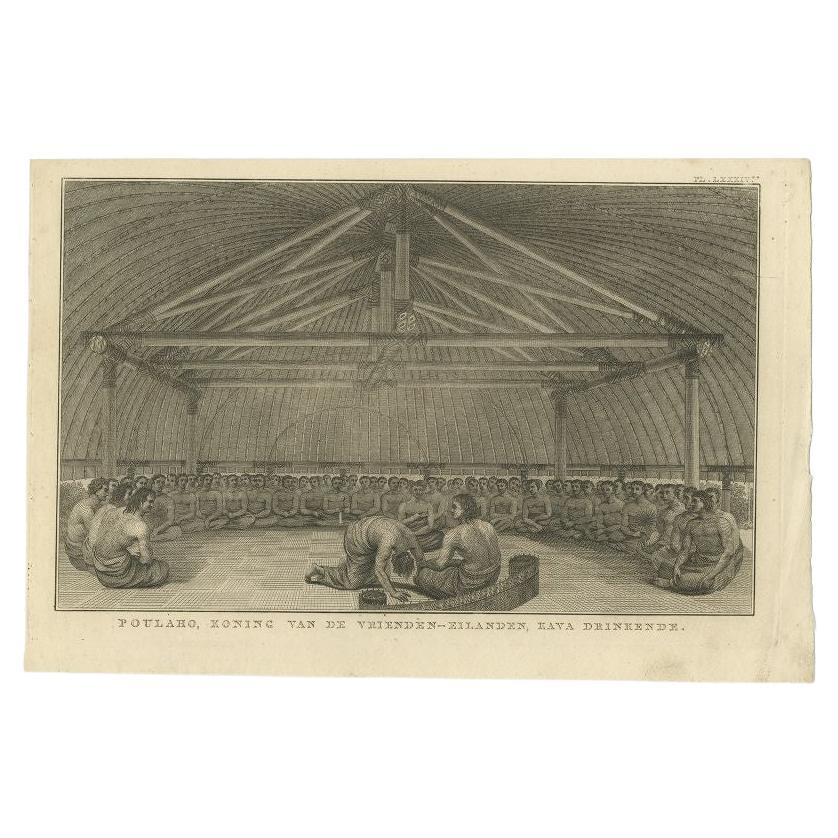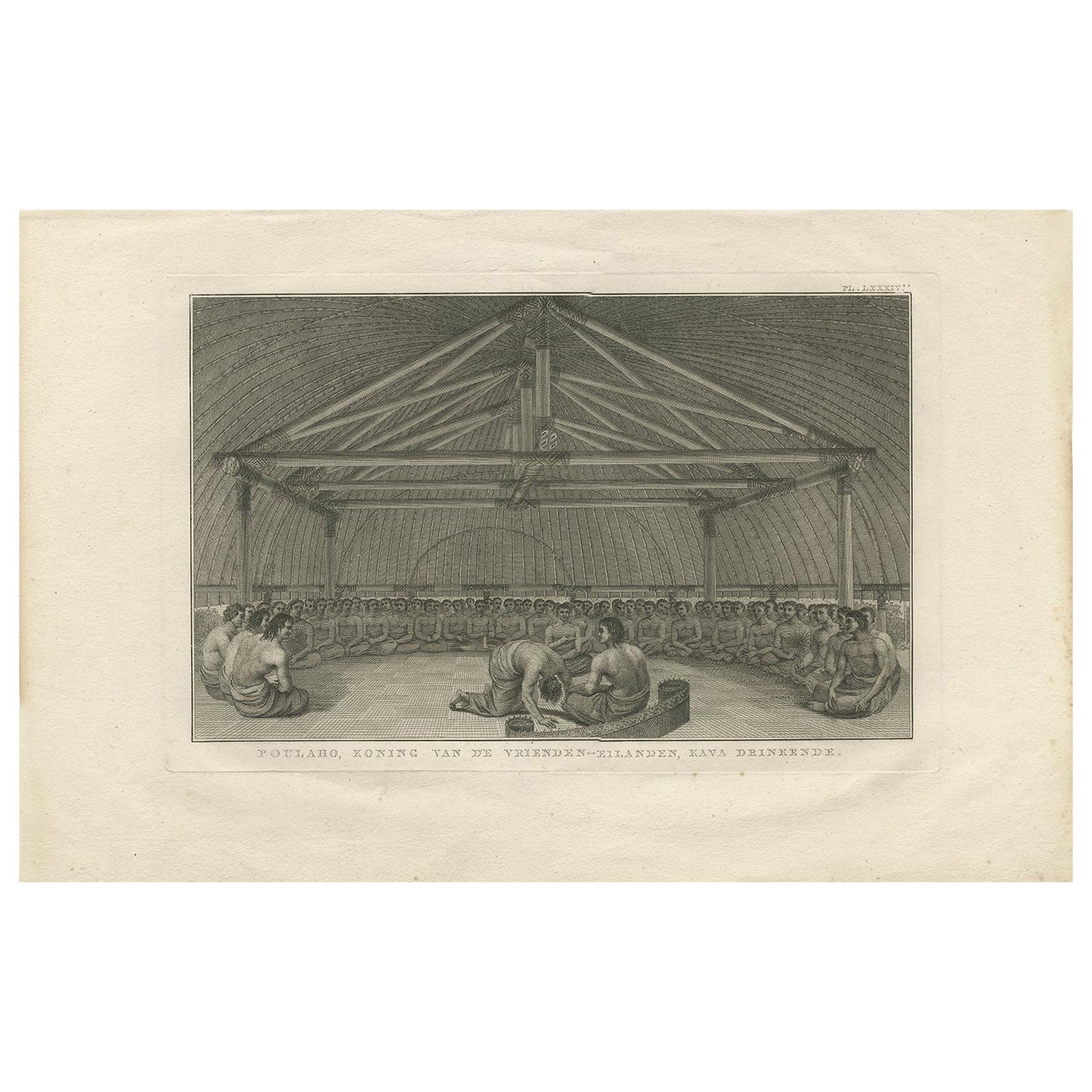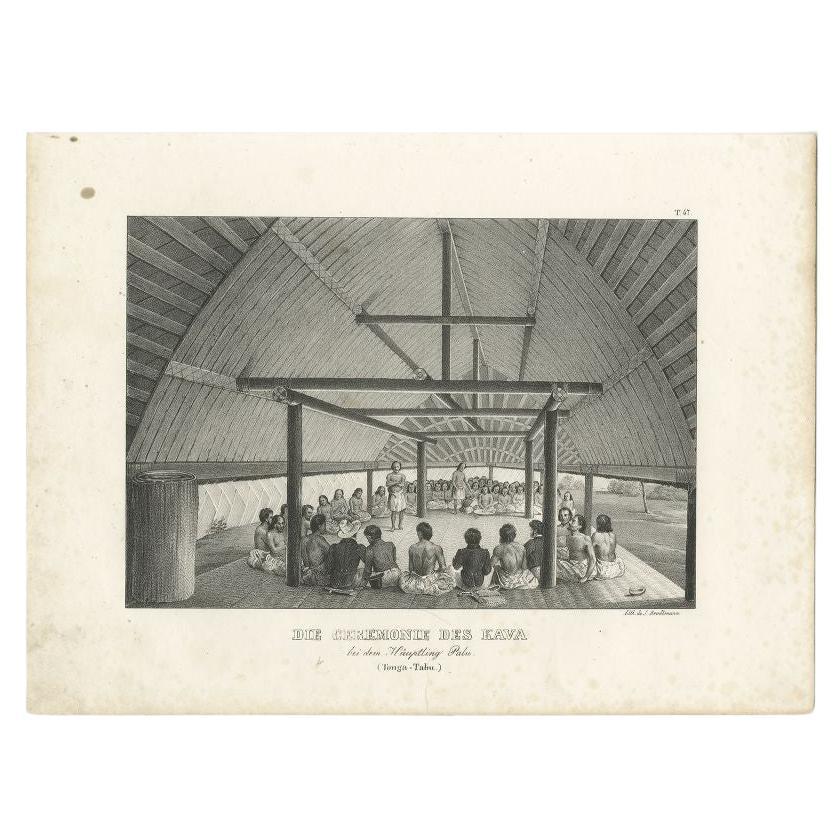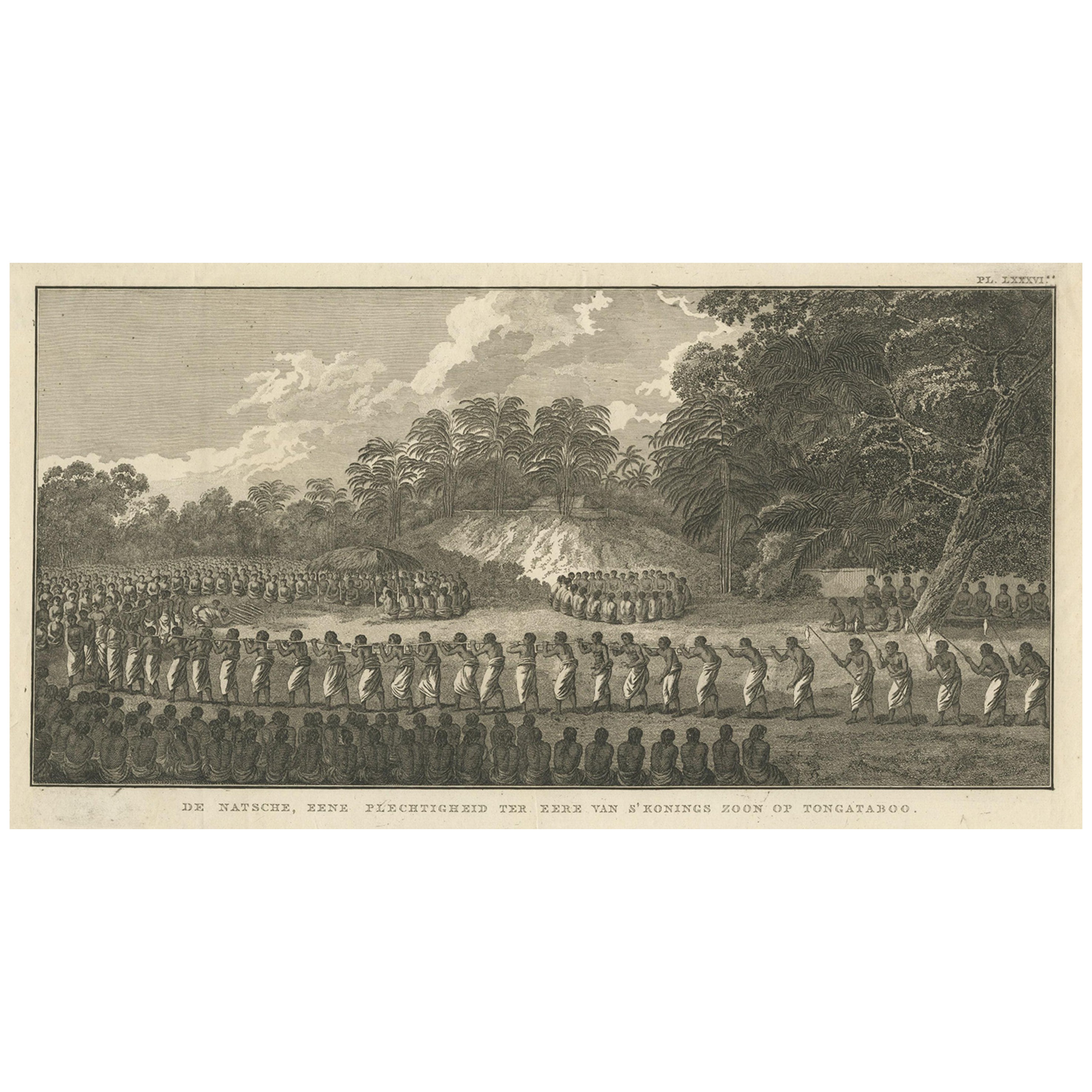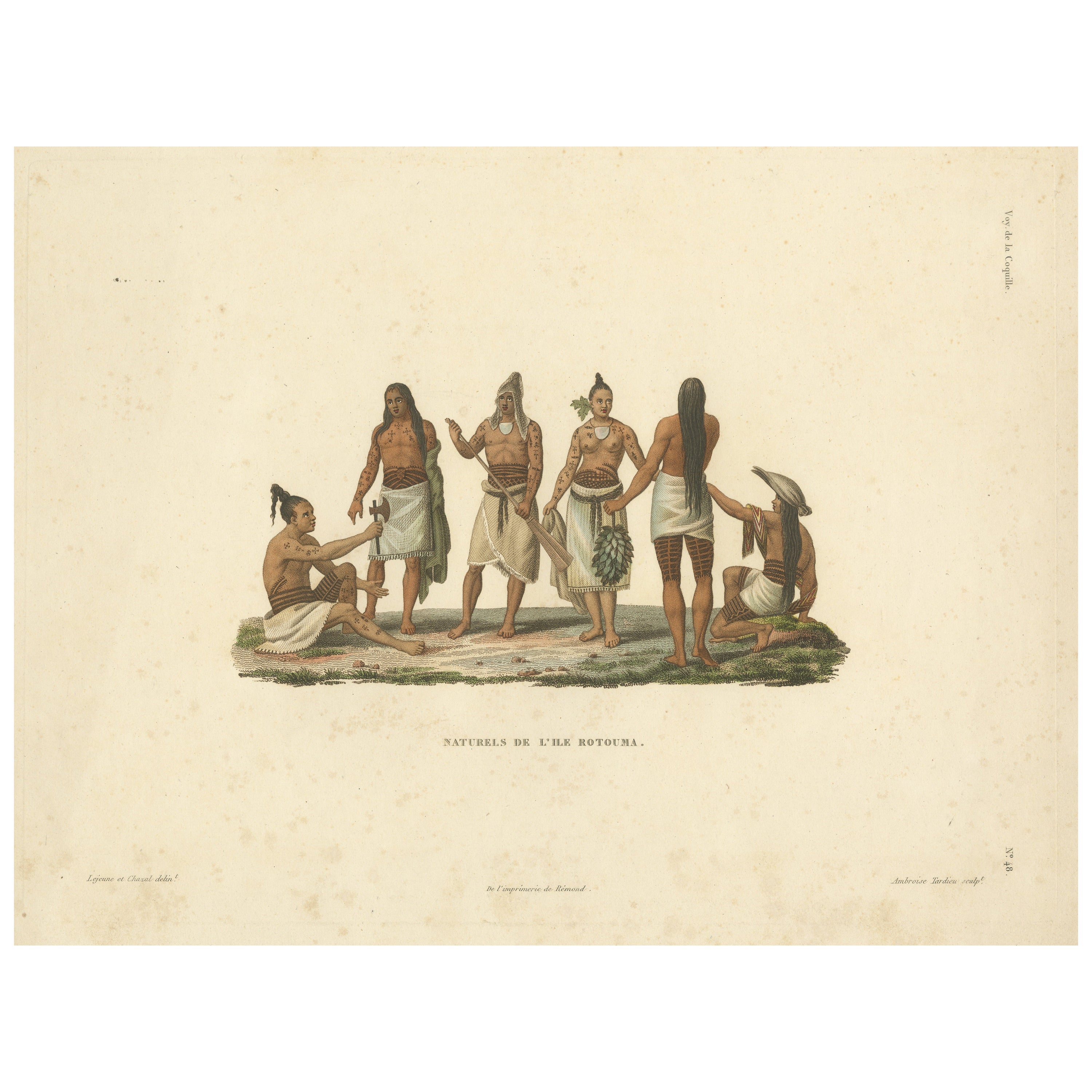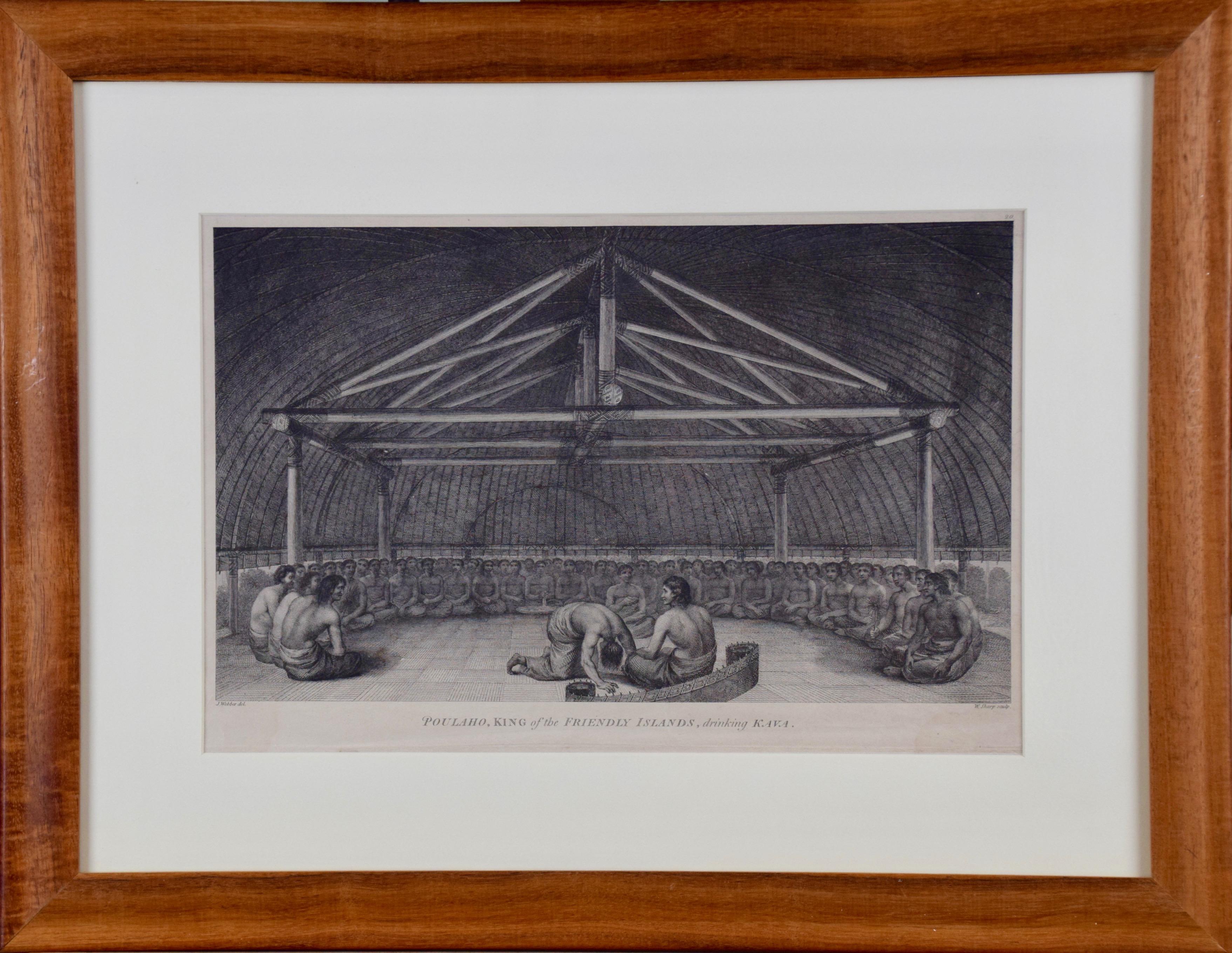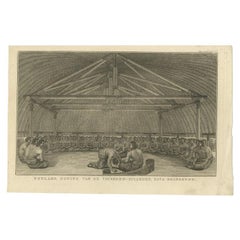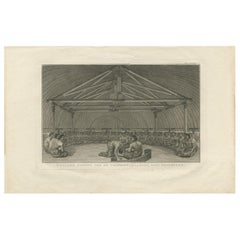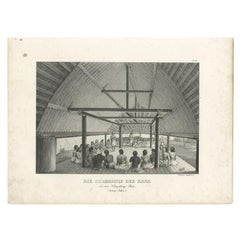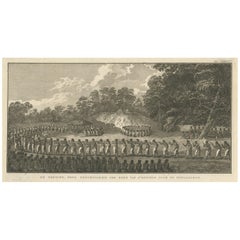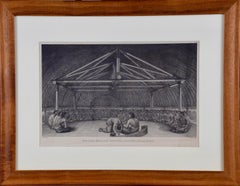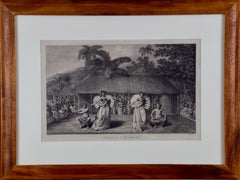Items Similar to Poulaho, King of Tonga, Participating in a Kava Ceremony in the Friendly Islands
Want more images or videos?
Request additional images or videos from the seller
1 of 7
Poulaho, King of Tonga, Participating in a Kava Ceremony in the Friendly Islands
$133.41
$166.7720% Off
£99.90
£124.8820% Off
€112
€14020% Off
CA$185.94
CA$232.4220% Off
A$203.93
A$254.9120% Off
CHF 106.65
CHF 133.3120% Off
MX$2,463.98
MX$3,079.9820% Off
NOK 1,338.14
NOK 1,672.6720% Off
SEK 1,261.36
SEK 1,576.7020% Off
DKK 852.63
DKK 1,065.7920% Off
About the Item
The engraving is titled "Poulaho, King of the Friendly Islands, Drinking Kava." It depicts a ceremonial scene with Poulaho, the King of the Friendly Islands (modern-day Tonga), participating in the traditional kava-drinking ceremony. The setting is a large meeting house, with many participants sitting in rows, observing the ritual. The image reflects the significance of kava as part of Tongan ceremonial and cultural life.
This engraving captures an important cultural ritual of the Friendly Islands (Tonga) in the late 18th century, showing King Poulaho engaged in the kava-drinking ceremony. Kava, a drink made from the root of the kava plant, holds great ceremonial importance in Tongan and other Pacific Island cultures, used in formal gatherings, religious rituals, and to honor chiefs and royalty. The king is shown seated with attendants, who are preparing the kava in front of him, while numerous individuals sit in concentric rows inside a large thatched meeting house, likely a traditional 'fale'.
This scene is drawn from accounts of Captain Cook’s third voyage, where he visited Tonga in 1777. The image is typical of 18th-century European engravings that sought to depict the customs and rituals of Indigenous cultures encountered during these explorations. The publication that features this engraving was published by Alex Hogg in London, around 1784-86, as part of a series that chronicled the voyages of Captain James Cook and other explorers. The kava ceremony was one of the many cultural practices noted during Cook’s interactions with Tongan society, particularly as it emphasized the hierarchical and ritualistic aspects of Polynesian governance.
This engraving serves as an ethnographic record of Tongan society and its customs, as observed by European explorers. The kava ceremony, a deeply significant cultural practice, is portrayed with attention to the social structure of the event, including the positioning of the king and the gathering of the people. The image also reflects the broader European interest in documenting the ceremonial practices of non-Western cultures during the age of exploration.
Interesting Aspects:
- The structure of the fale (meeting house) is intricately detailed, showcasing the traditional architecture with its wooden supports and thatched roof.
- The formal arrangement of the participants, all seated and watching the ceremony, reflects the respect and importance of the occasion.
- The focus on Poulaho, the king, emphasizes the hierarchical nature of Tongan society, where the kava ceremony is a key aspect of leadership and authority.
- The depiction of the kava preparation, with attendants working before the king, gives insight into the traditional roles involved in the ceremony.
This engraving provides valuable insight into the ceremonial life of the Friendly Islands and serves as a visual record of the interactions between European explorers and the cultures of the Pacific.
- Dimensions:Height: 9.45 in (24 cm)Width: 15.04 in (38.2 cm)Depth: 0 in (0.02 mm)
- Materials and Techniques:Paper,Engraved
- Period:1780-1789
- Date of Manufacture:circa 1785
- Condition:Condition: fair, given age. With soiling and light foxing. General age-related toning and minor defects from handling. Lower border cut off rough, outside the image. Study images carefully.
- Seller Location:Langweer, NL
- Reference Number:Seller: BG-13597-471stDibs: LU3054341693632
About the Seller
5.0
Recognized Seller
These prestigious sellers are industry leaders and represent the highest echelon for item quality and design.
Platinum Seller
Premium sellers with a 4.7+ rating and 24-hour response times
Established in 2009
1stDibs seller since 2017
2,653 sales on 1stDibs
Typical response time: <1 hour
- ShippingRetrieving quote...Shipping from: Langweer, Netherlands
- Return Policy
Authenticity Guarantee
In the unlikely event there’s an issue with an item’s authenticity, contact us within 1 year for a full refund. DetailsMoney-Back Guarantee
If your item is not as described, is damaged in transit, or does not arrive, contact us within 7 days for a full refund. Details24-Hour Cancellation
You have a 24-hour grace period in which to reconsider your purchase, with no questions asked.Vetted Professional Sellers
Our world-class sellers must adhere to strict standards for service and quality, maintaining the integrity of our listings.Price-Match Guarantee
If you find that a seller listed the same item for a lower price elsewhere, we’ll match it.Trusted Global Delivery
Our best-in-class carrier network provides specialized shipping options worldwide, including custom delivery.More From This Seller
View AllEngraving of King Poulaho of the Friendly Islands (Tonga) drinking Cava, ca.1801
Located in Langweer, NL
Antique print titled 'Poulaho, Koning van de Vrienden-Eilanden, Kava drinkende'. This print depicts King Poulaho drinking Cava. Originates from 'Reizen rondom de Waereld' by J. Cook....
Category
Antique 19th Century Prints
Materials
Paper
$333 Sale Price
20% Off
Antique Print of King Poulaho of the Friendly Islands by Cook, 1803
Located in Langweer, NL
Antique print titled 'Poulaho, Koning van de Vrienden-Eilanden, Kava drinkende'. This print depicts King Poulaho drinking Cava, Friendly Islands or nowadays Hawaii. Originates from '...
Category
Antique Early 19th Century Dutch Prints
Materials
Paper
$209 Sale Price
20% Off
Antique Print of a Kava Ceremony on Tonga Tabu, c.1836
Located in Langweer, NL
Antique print titled 'Die Ceremonie des Kava bei dem Häuptling Palu'. Old print depicting a Kava Ceremony on Tonga Tabu. This print originates from 'Entdeckungs, Reise der Franzosischen Corvette Astrolabe Unternomen auf Befehl Konig Karls...
Category
Antique 19th Century Prints
Materials
Paper
$314 Sale Price
20% Off
De Natsche – Ceremony for the King's Son, Tonga c.1795
Located in Langweer, NL
De Natsche – Ceremony for the King's Son, Tonga c.1795
This antique print depicts a grand ceremony held in honour of the son of the King of Tonga, known as the Natsche, in the villa...
Category
Antique Early 1800s European Prints
Materials
Paper
$562 Sale Price
20% Off
"Natives of the Island of Rotuma: Antique Ethnographic Print, circa 1825
Located in Langweer, NL
This antique print titled "Naturels de l'Ile Rotouma" depicts the indigenous people of the Island of Rotuma. The print offers a glimpse into the appearance and attire of the island's...
Category
Antique Mid-19th Century Prints
Materials
Paper
$362 Sale Price
20% Off
Celebration of Tahitian Culture: Traditional Dance at Otaheite, circa 1785
Located in Langweer, NL
An antique engraving depicting a dance scene titled "An Exact Representation of a Dance in Otaheite," Otaheite being an archaic name for Tahiti in French Polynesia. This engraving would have been created as a part of a series to document the culture and life of the Tahitian people, likely observed by European explorers during one of the many voyages to the South Pacific in the 18th century.
In the foreground, there are central figures engaged in a dance, wearing traditional Polynesian attire, which includes wraps around their waists and adornments that seem to represent status or a part of the dance costume. They are holding what appear to be fans, which may be part of the traditional dance. The dancers' poses suggest movement and a performance aspect to the scene.
Behind the dancers, we can see a group of musicians providing the accompaniment, playing drums, which indicates the importance of music and rhythm in the dance. To the right, there is an audience of seated individuals, likely members of the community, watching the performance.
The background of the scene includes thatched huts and a lush landscape with palm trees, depicting a typical village setting in Tahiti. The checkerboard pattern on the ground where the dance takes place is notable, as it adds a sense of structure to the scene.
This image would have been intended for a European audience unfamiliar with Tahitian culture and would have served as a visual record of the encounters between European explorers and the peoples of the Pacific Islands.
The engraving you've uploaded, titled "An Exact Representation of a Dance in Otaheite," is likely from a work documenting the voyages of Captain James Cook, given the style and subject matter. Captain Cook made three voyages to the Pacific Ocean during the 18th century, and his encounters with the peoples of the Pacific, including those of Tahiti (Otaheite), were extensively recorded and published.
The engravings from Cook's voyages were made by artists who accompanied him, such as John Webber on his third voyage, or were based on sketches made by other crew members. These images were then published in the official accounts of the voyages. The most notable of these accounts is "A Voyage to the Pacific Ocean" undertaken during Cook's third voyage from 1776 to 1780, which was published in the years following his death in 1779.
Another possible source for this engraving could be from the accounts of Joseph Banks. Banks was a naturalist who joined Cook on his first voyage (1768-1771) aboard the HMS Endeavour and was responsible for extensive collections and descriptions of Pacific cultures. His collections and later works also included illustrations and engravings of the scenes and peoples encountered.
Given that the engraving is labeled as "London Published as the Act directs by Alexr. Hogg at the Kings Arms...
Category
Antique 1780s Prints
Materials
Paper
$95 Sale Price
20% Off
You May Also Like
"King of the Friendly Islands" (Tonga); Engraving from Captain Cook's 3rd Voyage
By John Webber
Located in Alamo, CA
"Poulaho, King of the Friendly Islands, Drinking Kava" is an engraving created by William Sharp (1749-1824), from a drawing by John Webber (1752-1793), who was the artist on Captain James Cook's 3rd and final voyage of discovery. It was published in the atlas of "A Voyage to the Pacific Ocean Undertaken by the Command of His Majesty, for Making Discoveries in the Northern Hemisphere", the official British Admirality sanctioned journal published upon completion of the voyage in London in 1784 by Strahan & Cadell.
Captain Cook visited Tonga on his 3rd voyage, which he named The Friendly Islands because of the warm welcome he and his crew received, unlike some of the other more hostile Pacific islands. The engraving depicts Cook and his men observed a kava ceremony at the village of Mu’a on Tongatapu. King Paulaho sits in the centre foreground, his back to the spectator with a man kneeling before him. The ceremonial mat depicted behind Paulaho indicates that nobody was allowed to sit behind him. The figure in the centre holds a single cup, referring to the Tongan custom of offering the cup to the king first. Kava is native to the islands of the South Pacific and was first described for English readers in 1768 by Captain James Cook. The kava root has been used for centuries as a central feature of ceremonies and celebrations because it was able to bring about a calming and pleasant social atmosphere. The root was crushed and processed into coconut milk to become the focal ceremonial beverage, simply referred to as kava.
This engraving is presented in a Koa wood frame and a white mat. Koa wood is legendary in Hawaii. There are occasional faint spots, but the print is otherwise in very good condition. This amazing Koa wood is native to Hawaii and it is known for the deep rich colors and varied grain pattern. Koa has an honored heritage in Hawaii and is highly revered and sacred. The word “koa” means “warrior” in Hawaiian. The warriors of King Kamehameha the Great, created canoes and weapons from a wood plentiful on the Big Island of Hawaii. This wood became synonymous with the warriors themselves, and it became known as koa.
There are three other engravings listed from the official journal of Captain Cook's 3rd voyage available that are presented in identical Koa wood frames and mats (LU117324682422, LU117324684052, LU117324684032). They would make a wonderful grouping for a display of 2, 3 or 4 prints. A discount is available for a grouping depending on the number of items included.
Captain Cook is remembered as one of the greatest explorers and navigators in history. His explorations included Australia, New Zealand and islands of the South Pacific and the northwest coast of North America. Hawaii was discovered by Captain Cook during this voyage. Hawaii was originally called The Sandwich Islands in honor of The Earl of Sandwich...
Category
1780s Realist Figurative Prints
Materials
Engraving
Reception for Captain Cook, Tonga: Original 18th C. Engraving, Cook's 3rd Voyage
By John Webber
Located in Alamo, CA
"The Reception of Capt. Cook in Hapaee" is an original 18th century engraving from a drawing by John Webber (1751-1793), who was the artist who accompanied Captain Cook on his third ...
Category
1780s Landscape Prints
Materials
Engraving
Guam, Convent and native inhabitants, mid 19th century lithograph. Oceania.
Located in Melbourne, Victoria
'Convento di agagna nell' Isola Guam. Occupazioni domestiche in Guam.'
Italian lithograph, c1841. Originally from 'Galleria universale di tutti i popoli del mondo' by Giuseppe Anton...
Category
Mid-19th Century Naturalistic Figurative Prints
Materials
Lithograph
"A Dance in Otaheite" (Tahiti), Engraving from Captain Cook's 3rd Voyage
By John Webber
Located in Alamo, CA
"A Dance in Otaheite" (Tahiti) is an engraving created by William Sharp (1749-1824), from a drawing by John Webber (1752-1793), who was the artist on Captain James Cook's 3rd and final voyage of discovery. It is a plate in the atlas of "A Voyage to the Pacific Ocean Undertaken by the Command of His Majesty, for Making Discoveries in the Northern Hemisphere", the official British Admirality sanctioned journal published upon completion of the voyage in London in 1784 by Strahan & Cadell.
Two women and two men wearing ceremonial costumes, performing a dance outdoors standing on a mat. Three men are playing the drums in the background, in front of a thatched roof building. An audience of men are sitting on both sides of the stage. By the time Webber arrived in Tahiti, 'south sea' imagery had become familiar. Webber gave concentrated attention to dance. He had the opportunity to distinguish the Tahitian dance from the more formalized dancing of Tonga. Whereas they seem to have called to mind the more formal dances of antiquity, the Tahitian dancing aroused memories of peasant and folk dancing.
This engraving is professionally framed in Koa wood. Koa wood is legendary in Hawaii. Not only is this amazing wood native to Hawaii, but it is known for the deep rich colors and varied grain pattern. Koa has an honored heritage in Hawaii and is highly revered and sacred. The word “koa” means “warrior” in Hawaiian. The warriors of King Kamehameha the Great, created canoes and weapons from a wood plentiful on the Big Island of Hawaii. This wood became synonymous with the warriors themselves, and it became known as koa.
The print is in excellent condition.
There are three other engravings listed from the official journal of Captain Cook's 3rd voyage available that are presented in identical Koa wood frames and double mats (LU117324682432, LU117324684052, LU117324684062). They would make a wonderful grouping for a display of 2, 3 or 4 prints. A discount is available for a grouping depending on the number of items included.
Hawaii was discovered by Captain Cook during this voyage. Hawaii was originally called The Sandwich Islands in honor of The Earl of Sandwich...
Category
1780s Realist Landscape Prints
Materials
Engraving
Kerels Henry, Kongo Indigenous Market, Etched and Colored
By Henri Kerels
Located in Leuven , BE
This authentic colored etch by Henry Ketels(1896-1956) depicts an indigenous market.
Measurements of this beautiful piece are 71.5 x 53 cm without frame, 91.5 x 72 cm with frame.
...
Category
20th Century Belgian Prints
Materials
Other
Original Antique Ethnographical Print, Figures, New South Wales, Australia, 1809
Located in St Annes, Lancashire
Wonderful ethnographical print.
A copper-plate engraving after Lesieur
Published by Sherwood, Neely & Jones. Dated 1809
Unframed.
Category
Antique Early 1800s English Folk Art Prints
Materials
Paper
More Ways To Browse
Kava Kava
Vintage Rooster Plates
Vintage Stetson
Vintage Sunroom Furniture
Vintage Wall Thermometer
Vintage Woodworking Tools
Wall Secretary
Wheat Pattern
Whimsical Pottery
White Ceramic Elephant
White Lion Sculpture
White Swedish Commode
Wood Hand Carved Painted Chinese Statues
Wood Hindu
Zebra Cushion
15th Century Chinese Porcelain
1933 Worlds Fair
1950s Vintage Television
